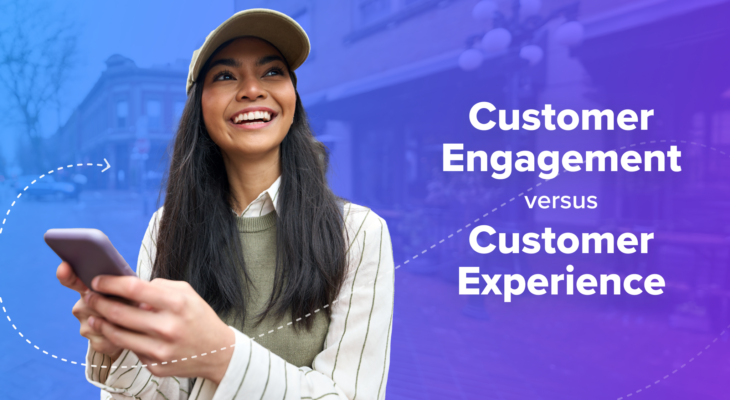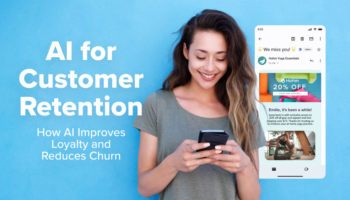A happy and content customer is a company’s true asset. For any business, however big or small, there can be no better advocate than its customer community. That’s why organizations are so rightly focused on being ‘customer-centric’. Two terms that often arise in discussions surrounding customer-centricity are “customer experience” and “customer engagement.” While the terms may seem interchangeable, they actually represent distinct aspects of the customer journey. Considering the current scenario, with so many businesses going ‘digital-first’, things become more interesting as we examine online customer experience and digital customer engagement.
In this blog post, we will delve into the nuances, compare customer experience and customer engagement, and explore how they impact businesses in the digital age.
Understanding Customer Experience
Customer experience (CX) refers to the overall perception and impression a customer has of a brand or organization throughout their entire journey, encompassing every touchpoint and interaction. It is the cumulative result of a customer’s encounters with a company, ranging from contact center and web interactions to post-purchase support. Customer Experience is about creating a positive, satisfying, and seamless overall impression for customers, ensuring their interactions are enjoyable, convenient, and memorable at every stage.
A great CX is:
- Seamless across devices and channels
- Personalized and relevant
- Emotionally resonant (i.e., customers feel heard and valued)
In short, CX is about the customer’s perception: how it feels to interact with your brand.
Key metrics: NPS, CSAT, CES, customer sentiment
Understanding Customer Engagement
Customer engagement, on the other hand, refers to the process of actively involving customers in meaningful interactions with a brand. This can be achieved with a certain set of tools, techniques, strategies, and by effectively implementing those strategies. Customer engagement aims to create loyal and committed customers who readily participate in brand activities, advocate for the brand, and provide feedback.
Great CE means:
- Creating interactive touchpoints (emails, push, in-app messages)
- Encouraging feedback and participation
- Driving loyalty through relevant content and offers
CE is focused on behavior: what your brand does to keep the relationship active and growing.
Key metrics: Open rate, CTR, repeat purchases, time spent, retention
CX vs. CE: Key Differences at a Glance
| Element | Customer Experience (CX) | Customer Engagement (CE) |
|---|---|---|
| Focus | How the customer feels | What the brand does |
| Measurement | Sentiment & satisfaction (NPS, CSAT) | Interaction & loyalty (CTR, LTV) |
| Directionality | Customer-driven perception | Brand-initiated interaction |
| Timeframe | Across the full customer journey | Throughout ongoing interactions |
| Objective | Create trust and satisfaction | Inspire action and advocacy |
The Synergy between Customer Experience and Customer Engagement
One poor interaction can be all it takes to lose a customer. Over 50% of customers say they would switch to a competitor after just one negative experience. That means even the most well designed engagement strategies can be undone by a poor experience.
While customer experience and customer engagement have distinct focal points, they are not mutually exclusive. In fact, they complement each other and work hand in hand to create a holistic and customer-centric approach.
Customer engagement is built on the foundation of a positive customer experience. A great CX creates trust and makes customers more likely to engage. In fact, 91% of marketing leaders say that personalized, cross-channel experiences are essential for improving customer retention, according to a recent Blueshift survey. On the other hand, strong engagement reinforces the experience by providing more value, deepening relationships, and fueling feedback loops that improve CX.
For example:
- A smooth website interface (CX) encourages browsing.
- Follow-up recommendations and offers () prompt return visits.
- Insights from customer engagement data inform improvements in UX (CX).
When brands unify both, they:
- Create high quality, memorable experiences that earn loyalty
- Use engagement data to refine CX
- Build a flywheel of trust, action, feedback, and optimization
Think Netflix: its smooth interface (CX) makes discovery easy, while its hyper personalized recommendations (CE) keep users coming back.
What Does Effective Customer Engagement Look Like?
- Highly Personalized Customer Journeys: Unlike customer experience, which is primarily influenced by the brand, customer engagement involves a mutual exchange between the brand and the customer. This implies personalized 1:1 interactions with the customers about the things they are interested in. It involves knowing the customers well, and mapping their journeys with a view to creating personalized experiences. Understanding the users’ affinities and providing them with exactly what they need considering their likes and dislikes is what personalization encompasses.
- Value Across Every Interaction: Customer engagement goes beyond one-off transactions, focusing on fostering loyalty and advocacy through ongoing engagement initiatives. Brands have to ensure that they bring the maximum value with every interaction they have with the customers. It is important to design customer journeys that would enable growth in engagement throughout the customer lifecycle. This is what it means to be truly customer-centric.
- Cross-Channel Customer Experiences: With the rise of digital experiences at the forefront and with a plethora of multiple channels and smart devices at the customers’ disposal, an intuitive cross-channel customer experience is what marketers should focus on. Ensuring that customer interactions are consistent and seamless across all channels is key to customer success. Being able to engage with users wherever they are, irrespective of the channel or the medium is one step closer to a positive customer experience.
Ingredients of Intelligent Customer Engagement: What Do Marketers Need
- Real-Time CDP – To ensure the most efficient customer engagement, companies need to work with a platform that can capture, process, and unify substantial volumes of customer data that includes historic interactions, customer behaviors, and predicted future actions. With a real-time CDP, all this data can be leveraged to reach every customer on a personal level, with better targeting and a deeper understanding of behaviors.
- Cross-Channel Hub – Another key ingredient is a cross-channel hub that connects all the marketing channels and applications and guides interactions throughout the customer journey by being responsive to customer behaviors. This directly correlates to a consistent customer experience and ultimately to positive customer engagement.
- AI-Powered Personalization – The power of AI enables marketers to present their customers with relevant content and products that will drive the highest engagement. With AI, customers can be reached at the precise time they are most likely to interact, thus boosting customer engagement
Discussing effective customer engagement, Joyce Poole, Senior Director of Marketing CRM at LendingTree, emphasizes the importance of tailored experiences. She shares, “If you’re really thinking about how to customize to the nth degree, you have to go with a platform like Blueshift that has all the tools to make robust journeys smarter and customer engagement more effective. You have the ability to coordinate and personalize multiple channels in a customer journey at the push of a button.”
In the current landscape, businesses must prioritize both customer experience and customer engagement to thrive. Providing customers with an exceptional online experience lays the foundation for building meaningful engagement, fostering loyalty, and driving business growth. Blueshift is an intelligent customer engagement platform that focuses on all the above aspects to elevate brands’ customer experiences to the next level. By leveraging Blueshift’s rich data, personalization, AI, and cross-channel capabilities, organizations can create a customer-centric ecosystem that resonates with today’s tech-savvy consumers. As the digital revolution continues to unfold, organizations that understand and capitalize on the synergy between customer experience and customer engagement will emerge as the frontrunners in their respective industries.
Want to learn more about delivering cross-channel experiences? Download our Smart Guide to Cross-Channel Campaigns.



